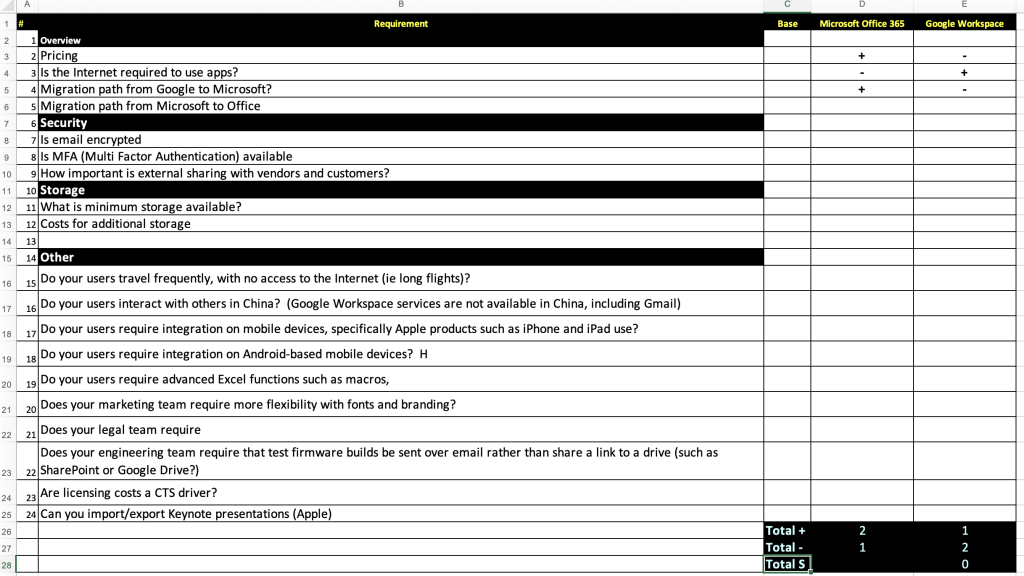
I think it’s time that I provide a little refresher on some basic Six Sigma Tools. Recently, I was tasked to complete a company-wide Office 365 Migration to Google Workspace (formerly G Suite). The migration was completed successfully and will be well detailed in a future blog post. But first, remember, there’s nothing wrong with using some of the Six Sigma tools in your proverbial quality management toolbox. I had to resort to my old notes and prepare something using Six Sigma to decide whether to use Office 365 or Google Workspace. That’s right, Office 365 or Google Workspace?
That’s right, we don’t need to launch an ambitious Six Sigma project for every problem or question that arises. Implementing full-blown Six Sigma can be an arduous task, even more so if you attempt it alone or in the current COVID-19 pandemic situation where many people work from home (this is not to say that you can’t propose a Lean Six Sigma approach to your manager for processes or other goals involving colleagues on a Zoom or Microsoft Teams video meeting.)
A topic that comes up frequently is whether a company should use Microsoft Office 365 or Google Workspace. This question arises in my workplace, by my colleagues in my professional network (you guessed it, LinkedIn), and
Today, we’ll just pick a few tools to determine the best product to use, however, let’s remember that one of the most important points to consider when beginning a Six Sigma project is with an effective, agreed-upon problem definition.
To do that, we need to scope out the problem so that we can evolve that into an actionable requirement, and thus a repeatable and measurable solution. Sounds simple?
I also encourage to challenge yourself in whether DMAIC or DFSS would be the best approach (note: I am hearing less and less of DFSS and Evolutionary Operations; I think this is to say that Lean Six Sigma is really prevailing in this area, but I digress.)
For example, to make a simple decision, I may not suggest using a SIPOC, QFD (Quality Function Deployment), or a Value Stream Map, as these are process-based tools, or tools that will help us improve or optimize a process. We just want to define the problem, scope it, and use a simple tools such as the Pugh Matrix.
Eventually, once the decision to use Office 365 or Google Workspace has been established, we can perform VOC (Voice of the Customer) activities (ie Kano Analysis, Gap Analysis, or Change Plot) afterwards to ensure that all our users (probably our work colleagues) remain satisfied. Then again, if this was a large Six Sigma project, I would encourage conducting the Kano Analysis beforehand to ensure the important, weighted requirements rose to the top.
Let’s Better Frame or Scope the Problem Statement
Back to the original question: Should you move forward with Office 365 or Google Workspace in your organization? For your collaborative office work suite, that is.
This is a tough question, that needs lots of attention. First of all, do you already use one of these products? Is your goal to streamline your internal business operations? or keep costs down (per your Finance department)? Collaborate more seamlessly between colleagues across different geographies and time zones? Make your customer complaint process easier for your customers?
To facilitate this process, I’ll introduce some requirements to help us along. Let’s start with the premise that the company has already long been using Microsoft 365 (once known as Microsoft Office 365), and whether it makes more sense for the customer experience and lower user costs to move towards Google Workspace.
As a long time Office 365 tenant, our CEO experienced several poor Microsoft experiences, and he wants nothing to do with their products (a product boycott, let’s say). Specifically, his complaints can largely be attributed to trying to a SharePoint link to someone by email. An attempt to share a document from SharePoint can prove unnecessarily challenging. Furthermore, he feels he has business to conduct with Larry Page and Sergey Brin so he wouldn’t dare try to reach them for a product demo or pitch from a Microsoft platform. He feels he should use Gmail to contact the Google founders. Zoom at least, God forbid Microsoft Teams.
As the founder of a software development studio, my CEO feels that those who use Microsoft Outlook are dated or belong in a boring accountant’s office. He feels the Millennials and Gen Zs he hired prefer collaborating on G Suite (still refers to G suite many months after Google re-christened their flagship office suite from G Suite to Google Workspace, but you should all know this by now.)
The Finance Department also got wind of the CEO’s wishes and they further support this move as they are well aware that Google Workspace lowers the cost significantly from $20 per user per month to $12 per user per month.
Wait a minute!
Nor will there be any Hypothesis Testing or MSA (Measurement System Analysis) as we don’t have the luxury of trying both alternatives. Our users need to continue to work, collaborate, and send emails seamlessly. It would be unreasonable to ask folks to switch email clients repeatedly.
Pugh Matrix
Remember the Pugh Matrix? It is a matrix-based tool used to help decide between comparative products or services, based on your team’s CTSs (Critical to Satisfaction) criteria. Features, or functionality and are then weighted according to their importance
Here are a few CTS examples to help decide whether upon using Google Workspace or Microsoft Office 365.
- Do your users travel frequently, with no access to the Internet (ie long flights)?
- Do your users interact with others in China? (Google Workspace services are not available in China, including Gmail)
- Do your users require integration on mobile devices, specifically Apple products such as iPhone and iPad use?
- Do your users require integration on Android-based mobile devices? Here, Google will offer a more seamless integration than Microsoft
- Do your users require advanced Excel functions such as macros,
- Does your marketing team require more flexibility with fonts and branding?
- Does your legal team require
- Does your engineering team require that test firmware builds be sent over email rather than share a link to a drive (such as SharePoint or Google Drive?)
- Are licensing costs a CTS driver?
- Do you use Apple products such as Keynote presentations?

Or, are you actually considering moving from one platform to another? Are you considering moving from one platform to another? For example, are you considering moving your Office 365 instance to Google Workspace? If so, you’ll need to consider the migration paths.

